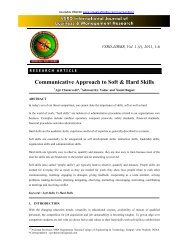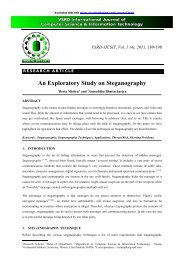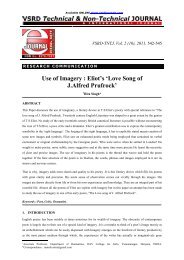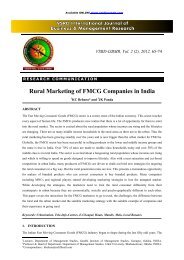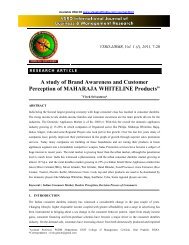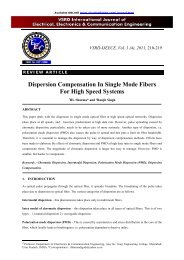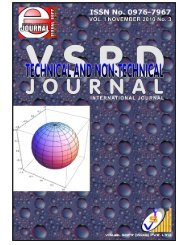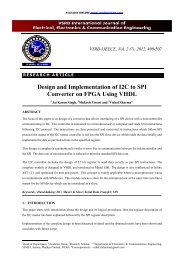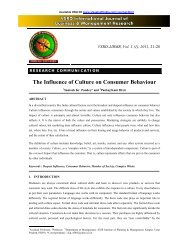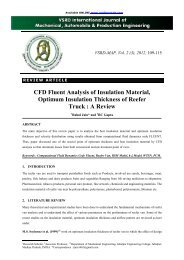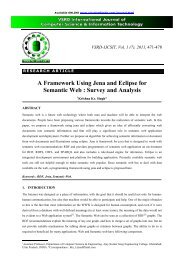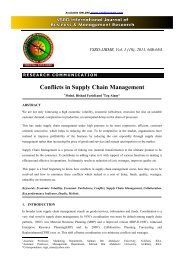Download Complete Article in PDF Format - vsrd international ...
Download Complete Article in PDF Format - vsrd international ...
Download Complete Article in PDF Format - vsrd international ...
You also want an ePaper? Increase the reach of your titles
YUMPU automatically turns print PDFs into web optimized ePapers that Google loves.
R E S E A R C H A R T II C L E<br />
ABSTRACT<br />
____________________________<br />
Available ONLINE www.visualsoft<strong>in</strong>dia.com/journal.html<br />
VSRD-IJBMR, Vol. 1 (4), 2011, 232-244<br />
Enhanc<strong>in</strong>g F<strong>in</strong>ancial Inclusion: An Overview<br />
of the Catalytic Role of MFIs <strong>in</strong> India<br />
1 K. Sudesh Kr.* and 2 Sadananda Sahoo<br />
The purpose of this paper is to exam<strong>in</strong>e the role of micro f<strong>in</strong>ance <strong>in</strong> the empowerment of people and the<br />
realisation of f<strong>in</strong>ancial <strong>in</strong>clusion <strong>in</strong> India. With <strong>in</strong>creas<strong>in</strong>g demand for rural f<strong>in</strong>ance, and the <strong>in</strong>adequacies of<br />
formal sources, the MFIs have immense opportunities <strong>in</strong> the new avatar of micro credit <strong>in</strong> India. However, <strong>in</strong> the<br />
light of recent experiences and the need for qualitative growth, we suggest that MFIs should be managed with<br />
better scrut<strong>in</strong>y <strong>in</strong> terms of f<strong>in</strong>ance and technology as well as social responsibility. This is of utmost importance<br />
<strong>in</strong> order to upgrade MFIs from thrift and credit <strong>in</strong>stitutions to capacity-build<strong>in</strong>g and livelihood- susta<strong>in</strong><strong>in</strong>g<br />
associations of people. The paper exam<strong>in</strong>es the promise of microf<strong>in</strong>ance (credit plus services) <strong>in</strong> the <strong>in</strong>clusion<br />
(access) of excluded and to analyse the impact of the microf<strong>in</strong>ance on the social and economic welfare of the<br />
poor households.<br />
Keywords: F<strong>in</strong>ancial Inclusion, Microf<strong>in</strong>ance, Inclusive Growth, Self-Help Groups, Mfis.<br />
1. INTRODUCTION<br />
Poverty eradication and empowerment of the poor has been on the priority agenda of both central and state<br />
government, beg<strong>in</strong>n<strong>in</strong>g with First Five Year Plan <strong>in</strong> 1951. About 238 million people <strong>in</strong> India live below the<br />
poverty l<strong>in</strong>e with the per capita <strong>in</strong>come of less than one dollar per day (NSSO,2004-05,61 st round) 1 . The policy<br />
makers and practitioners got reflected <strong>in</strong> the successive five-year plans, which had the objectives of ‘growth<br />
with equity’ and ‘social justice’. The economists, however, realized that rapid growth did not br<strong>in</strong>g about<br />
‘trickle down’ effect, particularly so <strong>in</strong> rural areas. This realization led to the restructur<strong>in</strong>g of <strong>in</strong>stitutions and<br />
schematic lend<strong>in</strong>g to facilitate better accessibility of credit for the underprivileged. Thus, <strong>in</strong>itiatives <strong>in</strong> this<br />
regard were taken by build<strong>in</strong>g an <strong>in</strong>stitutional framework through nationalization of banks, creation of regional<br />
rural banks. Moreover, despite decades of aid, communities and families appear to be <strong>in</strong>creas<strong>in</strong>gly fractured,<br />
1 Assistant Professor, Department of Management & Account<strong>in</strong>g, Gaytri Bidya Parisad PG College, Vishakhapatnam,<br />
Andhra Pradesh, INDIA. 2 Senior Lecturer, Department of Management Studies, Gandhi Institute of Management Studies,<br />
Gunupur, Orissa, INDIA. *Correspondence : sksudesh394@gmail.com
K. Sudesh Kumar et. al / VSRD International Journal of Bus<strong>in</strong>ess & Management Research Vol. 1 (4), 2011<br />
offer<strong>in</strong>g a fragile foundation on which to build (Morduch, 1999) 2 .<br />
Amid the distressed news, enthusiasm is build<strong>in</strong>g about a set of unusual f<strong>in</strong>ancial <strong>in</strong>stitutions prosper<strong>in</strong>g <strong>in</strong><br />
distant corners of the country. The hope is that much poverty can be alleviated and the economic and social<br />
structures can be transformed fundamentally by provid<strong>in</strong>g f<strong>in</strong>ancial services to low <strong>in</strong>come households. These<br />
<strong>in</strong>stitutions, united under the banner of “microf<strong>in</strong>ance”, share a commitment to serv<strong>in</strong>g clients that have been<br />
excluded from the formal bank<strong>in</strong>g sector .<br />
Bank<strong>in</strong>g data reveal that credit exclusion is severe <strong>in</strong> 139 districts of the country. In these districts, only 10 per<br />
cent or less out of 100 persons have access to credit from the fact that the exclusion is large, there is also a wide<br />
variation across regions, social groups and asset hold<strong>in</strong>gs. The poorer the group, the greater is the exclusion<br />
(Rangarajan, 2007) 3 . The results of the All-India Debt and Investment Survey of 2002, also <strong>in</strong>dicate that the<br />
share of the non-<strong>in</strong>stitutional sources, <strong>in</strong> the total credit of the cultivator households, had <strong>in</strong>creased from 30.6<br />
percent <strong>in</strong> 1991 to 38.9 percent <strong>in</strong> 2002 (Karmakar, 2002) 4 . Further, a Rural F<strong>in</strong>ance Access Survey 2003,<br />
conducted by the World Bank and NCAER, revealed that 79 per cent of the rural households has no access to<br />
credit from formal sources (Basu, 2005) 5 . Hence, the tasks of microf<strong>in</strong>ance are the promotion of greater<br />
f<strong>in</strong>ancial <strong>in</strong>clusion and <strong>in</strong> the process improve the social and economic welfare of the poor.<br />
In this backdrop, the paper exam<strong>in</strong>es the promise of microf<strong>in</strong>ance (credit plus services) <strong>in</strong> the <strong>in</strong>clusion (access)<br />
of excluded and to analyse the impact of the “credit plus services”( also called as the “<strong>in</strong>tegrated approach” or<br />
“maximalist approach” <strong>in</strong> microf<strong>in</strong>ance) on the social and economic welfare of the poor households.<br />
Thus, important challenge fac<strong>in</strong>g the bank<strong>in</strong>g sector is to extend f<strong>in</strong>ancial services to all sections of society. Like<br />
others, the poor need a range of f<strong>in</strong>ancial services that are convenient, flexible, and affordable and not just loans.<br />
At this juncture the <strong>in</strong>troduction on “f<strong>in</strong>ancial <strong>in</strong>clusion” comes from the recognition that this can serve the<br />
<strong>in</strong>terests of both society and the bank<strong>in</strong>g system. As a complementary to this, micro-f<strong>in</strong>ance1 can work as a<br />
powerful tool to fight poverty became the effective approach of f<strong>in</strong>ancial <strong>in</strong>clusion. With the new philosophy<br />
and policies perta<strong>in</strong><strong>in</strong>g to micro credit, micro f<strong>in</strong>ance <strong>in</strong>stitutions (MFIs) such as Self Help Groups (SHGs) have<br />
emerged and they now have a strong foot<strong>in</strong>g <strong>in</strong> the develop<strong>in</strong>g countries such as Bangladesh, India etc.<br />
2. FINANCIAL INCLUSION FOR INCLUSIVE GROWTH<br />
F<strong>in</strong>ancial exclusion is a common phenomenon <strong>in</strong> rural areas. A large number of small and marg<strong>in</strong>al farmers,<br />
agricultural labourers and rural artisans are still excluded from wide range of f<strong>in</strong>ancial services. The challenges<br />
of achiev<strong>in</strong>g more <strong>in</strong>clusive growth can be met by a policy that encourages easier and affordable access to<br />
f<strong>in</strong>ancial services. F<strong>in</strong>ancial <strong>in</strong>clusion may be def<strong>in</strong>e d as the process of ensur<strong>in</strong>g access to f<strong>in</strong>ancial services and<br />
timely and adequate credit where needed by vulnerable groups such as weaker sections and low <strong>in</strong>come groups<br />
at an affordable cost .<br />
2.1. Approaches of F<strong>in</strong>ancial Inclusion<br />
Accord<strong>in</strong>g to C. Rangarajan there are six approaches <strong>in</strong> the system of F<strong>in</strong>ancial Inclusion, they are, as follows.<br />
� First, credit to the farmer households is one of the important elements of f<strong>in</strong>ancial <strong>in</strong>clusion among them<br />
Page 233 of 244
K. Sudesh Kumar et. al / VSRD International Journal of Bus<strong>in</strong>ess & Management Research Vol. 1 (4), 2011<br />
provid<strong>in</strong>g credit to the marg<strong>in</strong>al and sub marg<strong>in</strong>al farmers as well as other small borrowers is crucial to the<br />
need of he hour.<br />
� Second, rural branches must go beyond provid<strong>in</strong>g credit and extend a help<strong>in</strong>g hand <strong>in</strong> terms of advice on a<br />
wide variety of matters relat<strong>in</strong>g to agriculture.<br />
� Third, <strong>in</strong> district where population per branch is much higher than the national average. Commercial banks<br />
may be encouraged to open the branches.<br />
� Fourth, there is need for the simplification of the procedures <strong>in</strong> relation to grant<strong>in</strong>g of loans to small<br />
borrowers.<br />
� Fifth, the further strengthen<strong>in</strong>g the SHG-Bank L<strong>in</strong>kage Programme (BLP), as it has proved to be an<br />
effective way of provid<strong>in</strong>g credit to very small borrowers.<br />
� Sixth, the bus<strong>in</strong>ess facilitator and correspondent model needs to be effectively implemented.<br />
2.2. Indebtedness As An Indicator Of Inclusion<br />
Indebtedness to formal sources of credit is an <strong>in</strong>dicator of access to credit. Compared to earlier periods, access<br />
to formal credit decl<strong>in</strong>ed for cultivator households dur<strong>in</strong>g 1991-2002 (Table -1). Post bank nationalization,<br />
considerable <strong>in</strong>crease took place <strong>in</strong> the share of <strong>in</strong>stitutional sources <strong>in</strong> cultivators’ debt from about 32 per cent<br />
<strong>in</strong> 1971 to 66 per cent <strong>in</strong> 1991. However, the trend saw a reversal dur<strong>in</strong>g the 1990s and the share decl<strong>in</strong>ed to 61<br />
per cent <strong>in</strong> 2002 (Table-1). Among the <strong>in</strong>stitutional sources, the share of commercial banks <strong>in</strong>creased sizeably<br />
s<strong>in</strong>ce 1971. The co-operative sector’s share <strong>in</strong>creased from 22 per cent <strong>in</strong> 1971 to about 30 per cent by 1981 and<br />
stagnated s<strong>in</strong>ce then. In the 1990s, while cooperatives susta<strong>in</strong>ed their, albeit low, share at 30 per cent, the share<br />
of commercial banks slipped from 35 per cent <strong>in</strong> 1991 to 26 per cent <strong>in</strong> 2002. The decl<strong>in</strong>e <strong>in</strong> the share of<br />
<strong>in</strong>stitutional agencies <strong>in</strong> the 1990s can be attributed to the decl<strong>in</strong>e <strong>in</strong> the share of commercial banks. Formal<br />
Sector Credit to Rural Economy is still Low.<br />
Table 1 : Table 1: Relative Share of Borrow<strong>in</strong>g* of Cultivator Households<br />
Sources of Credit 1951 1961 1971 1981 1991 2002<br />
Institutional 7.3 18.7 33.7 63.2 66.3 61.1<br />
Cooperative Societies/Banks, etc 3.3 2.6 22.0 29.8 30.0 30.2<br />
Commercial Banks 0.9 0.6 2.4 28.8 35.2 26.3<br />
Non-Institutional 92.7 81.3 66.3 36.8 30.6 38.9<br />
Moneylenders 69.7 49.2 36.1 16.1 17.5 26.8<br />
Unspecified - - - - 3.1 -<br />
Total 100.0 100.0 100.0 100.0 100.0 100.0<br />
*Borrow<strong>in</strong>g refers to outstand<strong>in</strong>g cash dues.<br />
Source: NSSO, 59th Round, All India Debt and Investment Surveys, 2003.<br />
F<strong>in</strong>ancial <strong>in</strong>clusion is a key priority for India not only for susta<strong>in</strong><strong>in</strong>g the country’s high growth l<strong>in</strong>e but also for<br />
poverty alleviation at much faster pace and for bridg<strong>in</strong>g the growth rural-urban divide. This cannot happen<br />
Page 234 of 244
K. Sudesh Kumar et. al / VSRD International Journal of Bus<strong>in</strong>ess & Management Research Vol. 1 (4), 2011<br />
unless special efforts are made for deepen<strong>in</strong>g the market penetration of bank<strong>in</strong>g service to move from ‘class<br />
bank<strong>in</strong>g ’towards ‘mass bank<strong>in</strong>g’.<br />
2.3. Status Of F<strong>in</strong>ancial Inclusion In India<br />
To serve the f<strong>in</strong>ancial service requirements of the Indian population (over 1.1 billion) is characterized by a multi<br />
agency approach compris<strong>in</strong>g of a wide variety of formal, semi formal and <strong>in</strong>formal models with 50,000<br />
commercial bank branches, nearly 12,000 co-operative bank offices, over 15,000 regional rural bank (RRB)<br />
branches, over 100,000 primary agriculture credit societies (PACS), over 1000 Micro f<strong>in</strong>ance <strong>in</strong>stitutions<br />
(MFIs) and well over a million Self help groups (SHGs). Development of the credit delivery system <strong>in</strong> the<br />
country has metamorphosed from a monopoly of co-operatives to <strong>in</strong>duction of commercial banks and<br />
establishment of regional rural banks improv<strong>in</strong>g the outreach and ensur<strong>in</strong>g access to credit <strong>in</strong> rural areas.<br />
Despite this high density, branch <strong>in</strong>frastructure has not been able to deliver f<strong>in</strong>ancial services to low <strong>in</strong>come<br />
households due to (i) High fixed & operat<strong>in</strong>g costs result<strong>in</strong>g <strong>in</strong> high delivery cost (ii) Lack of sales <strong>in</strong>centives<br />
<strong>in</strong> cooperatives and regional rural banks (iii) Lack of products suited to the rural poor – lack of formal<br />
employment/ steady <strong>in</strong>come and absence of collateral makes them unsuitable for a bank<strong>in</strong>g product (at times<br />
because of regulatory constra<strong>in</strong>ts) (iv) Illiteracy <strong>in</strong> general & the lack of f<strong>in</strong>ancial knowledge (v) Lack of<br />
accessibility & reach of the traditional bank branches –Long distance and high cost of visit<strong>in</strong>g a bank is a<br />
prohibit<strong>in</strong>g factor, as it leads to loss of daily wage for a borrower (vi) Absence of private sector banks –<br />
operat<strong>in</strong>g model not feasible etc.<br />
Demographic penetration <strong>in</strong>dicates the outreach of bank<strong>in</strong>g sector <strong>in</strong> India as shown <strong>in</strong> Table-2.<br />
Region Current<br />
Accounts<br />
Table-2: Coverage of Bank<strong>in</strong>g Services <strong>in</strong> India<br />
Sav<strong>in</strong>gs<br />
Accounts<br />
Total<br />
Population<br />
Total No. Of<br />
accounts<br />
North 4215701 52416125 32676462 1 56631826 43<br />
North East 476603 6891081 38495089 7367684 19<br />
East 1814219 47876140 227613073 49690359 22<br />
Central 2202217 64254189 255713495 66456406 26<br />
West 3178102 49525101 149071747 52703203 35<br />
South 4666014 83386898 223445381 88052912 39<br />
All India 16552856 304349534 1027015247 320902390 31<br />
No. of acc. Per<br />
100 of population<br />
Source: Situation Assessment Survey 59th Round, National Sample Survey Organisation 2003<br />
One of the benchmarks employed to assess the degree of reach of f<strong>in</strong>ancial services to the population of the<br />
country, is the quantum of deposit accounts (current and sav<strong>in</strong>gs) held as a ratio to the population. As above<br />
Table-2 reveals that <strong>in</strong> northern region out of 100 persons only 43 persons hold a account <strong>in</strong> a bank. While<br />
com<strong>in</strong>g to the North Eastern Region it is quite low that is just 19. Thus table reveals that access to bank services<br />
is low, as well as there exists a large variation across the regions <strong>in</strong> credit accessibility. Another th<strong>in</strong>g is while<br />
compared to the developed world; the coverage of our f<strong>in</strong>ancial services is quite low. For <strong>in</strong>stance, as per a<br />
Page 235 of 244
K. Sudesh Kumar et. al / VSRD International Journal of Bus<strong>in</strong>ess & Management Research Vol. 1 (4), 2011<br />
recent survey commissioned by British Bankers' Association, 92 to 94 per cent of the population of UK has<br />
either current or sav<strong>in</strong>gs bank account (Leeladhar, 2005) 6 .<br />
Indicators like (i) number of loans per 1,000 persons and (ii) number of deposits per 1,000 persons capture the<br />
use of access to f<strong>in</strong>ancial/bank<strong>in</strong>g services as s given <strong>in</strong> Table-3.<br />
Table 3 : Deposit and Loan accounts <strong>in</strong> Rural and Urban India (per 1000 persons)<br />
Particulars Deposit accounts Credit accounts<br />
1996 2006 1996 2006<br />
Rural 322 325 63 62<br />
Urban 699 724 50 115<br />
It is evident from the above that there exists a rural-urban divide with respect to bank<strong>in</strong>g services <strong>in</strong> terms of<br />
‘usage’ also. And this divide has widened <strong>in</strong> the last decade. The number of deposit accounts (per 1000 persons)<br />
<strong>in</strong>creased from 322 <strong>in</strong> 1996 to 325 <strong>in</strong> 2006 <strong>in</strong> rural areas, whereas the comparable figures for urban areas was<br />
699 <strong>in</strong> which <strong>in</strong>creased to 724 <strong>in</strong> 2006. For credit accounts (per 1000 persons) there was a decl<strong>in</strong>e <strong>in</strong> the number<br />
of accounts dur<strong>in</strong>g the period 1996 to 2006 (Table-3). With 70 per cent of the population liv<strong>in</strong>g <strong>in</strong> the rural<br />
areas, a decl<strong>in</strong>e <strong>in</strong> the credit accounts and slow pace of <strong>in</strong>crease <strong>in</strong> the deposit accounts needs to be reversed.<br />
The figures ultimately reveal that there is lack of outreach of bank<strong>in</strong>g services to the population, at this juncture<br />
micro f<strong>in</strong>ance services do<strong>in</strong>g well <strong>in</strong> br<strong>in</strong>g<strong>in</strong>g excluded<br />
2.3.1. Extent of F<strong>in</strong>ancial Exclusion statistics <strong>in</strong> India, NSSO Survey 59th Round<br />
(a) General :<br />
� 51.4% of farmer households are f<strong>in</strong>ancially excluded from both formal / <strong>in</strong>formal sources .<br />
� Of the total farmer households, only 27% access formal sources of credit; one third of this group also<br />
borrow from non-formal sources.<br />
� Overall, 73% of farmer households have no access to formal sources of credit.<br />
(b) Region-wise :<br />
� Exclusion is most acute <strong>in</strong> Central, Eastern and North-Eastern regions – hav<strong>in</strong>g a concentration of 64% of<br />
all f<strong>in</strong>ancially excluded farmer households (from formal sources) <strong>in</strong> the country.<br />
� Overall <strong>in</strong>debtedness to formal sources of f<strong>in</strong>ance alone is only 19.66% <strong>in</strong> these three regions (4.09% for<br />
North-Eastern Region, 18.74% for Eastern Region and 22.41% for Central Region).<br />
(c) Occupational Groups :<br />
� Marg<strong>in</strong>al farmer households constitute 66% of total farm households. Only 45% of these households are<br />
<strong>in</strong>debted to either formal or non formal sources of f<strong>in</strong>ance (small farmers – 51%, medium farmers – 65.1%<br />
and large farmers – 66.4%).<br />
� About 20% of <strong>in</strong>debted marg<strong>in</strong>al farmer households have access to formal sources of credit (medium<br />
farmers – 57.6% and large farmers – around 65%).<br />
Page 236 of 244
K. Sudesh Kumar et. al / VSRD International Journal of Bus<strong>in</strong>ess & Management Research Vol. 1 (4), 2011<br />
� Among non-cultivator households nearly 80% do not access credit from any source.<br />
(d) Social Groups :<br />
� Only 36% of ST Farmer households are <strong>in</strong>debted (SCs and Other Backward Classes - OBC - 51%) mostly<br />
to <strong>in</strong>formal sources.<br />
Analysis of the data provided by the Basic Statistical Returns of Scheduled Commercial Banks reveal that<br />
critical exclusion (<strong>in</strong> terms of credit) is manifest <strong>in</strong> 256 districts, spread across 17 States and 1 UT, with a credit<br />
gap of 95% and above. This is <strong>in</strong> respect of commercial banks and RRBs. Credit coverage by cooperatives is<br />
also on a relatively low level, as nearly 62% of its members are non-borrow<strong>in</strong>g members.<br />
In the era of liberalization, the pursuit of f<strong>in</strong>ancial <strong>in</strong>clusion appears to be an arduous task (Chavan, 2007) 7 . But<br />
the country cannot afford to have an elite m<strong>in</strong>ority enjoy<strong>in</strong>g services offered by banks and a large unorganized<br />
majority <strong>in</strong> the cash and barter mode. This divide, apart from underm<strong>in</strong><strong>in</strong>g economic growth, could engender<br />
social tensions. Susta<strong>in</strong>ed growth of the nation and its cont<strong>in</strong>ued prosperity depend critically on universal<br />
f<strong>in</strong>ancial services coverage of all people (Sr<strong>in</strong>ivasan, 2007) 8 . Further, empirical evidence significantly raise<br />
growth, alleviate poverty and expand economic opportunity (Mor and Ananth, 2007) 9 .<br />
Therefore, need was felt for alternative policies, systems and procedures, sav<strong>in</strong>gs and loans products, other<br />
complementary services and new delivery mechanisms, which would fulfill the requirements of the poorest is<br />
“Microf<strong>in</strong>ance Intervention”.<br />
3. PLEDGING OF ‘CREDIT PLUS SERVICES’ IN FINANCIAL INCLUSION AND<br />
WELFARE FOR THE POOR<br />
The problem is that the poor do not have access to viable f<strong>in</strong>ancial options and, hence, tend to keep their wealth<br />
<strong>in</strong> physical goods such as cattle or gold. A publication by the National Council of Applied Economic<br />
Research—How India Earns, Spends and Saves, by Rajesh Shukla—shows that a quarter of urban families and<br />
more than 40% of rural families consider keep<strong>in</strong>g money at home as the preferred form of cash sav<strong>in</strong>gs. That’s<br />
millions of people treat<strong>in</strong>g the mattress at home as their bank. While micro credit does have a role to play <strong>in</strong><br />
advanc<strong>in</strong>g f<strong>in</strong>ancial <strong>in</strong>clusion, more attention needs to be paid to micro sav<strong>in</strong>gs. In an article published <strong>in</strong><br />
March, The Economist cited a survey of 166 microf<strong>in</strong>ance <strong>in</strong>stitutions <strong>in</strong> 2009 by the Microf<strong>in</strong>ance Information<br />
Exchange, which showed that all offered credit to the poor, but only 27% had sav<strong>in</strong>gs products. Grameen Bank<br />
is one of those that offer sav<strong>in</strong>gs options to members.<br />
Indian policymakers have been keen on this form of f<strong>in</strong>ancial <strong>in</strong>clusion, push<strong>in</strong>g banks to open no-frills<br />
accounts and try<strong>in</strong>g to route all payments made for work done <strong>in</strong> the Mahatma Gandhi National Rural<br />
Employment Scheme through banks.<br />
Ma<strong>in</strong>ta<strong>in</strong><strong>in</strong>g low-value bank accounts for the poor will be commercially profitable only if banks are able to drop<br />
costs through the smart use of technology. In January, the Bill and Mel<strong>in</strong>da Gates Foundation decided to provide<br />
grants worth $38 million “to help microlenders explore ways to make sav<strong>in</strong>gs accounts available to 11 million<br />
poor people across 12 countries <strong>in</strong> Africa, Asia and Lat<strong>in</strong> America over the next five years,” Joyce Lehman, a<br />
Page 237 of 244
K. Sudesh Kumar et. al / VSRD International Journal of Bus<strong>in</strong>ess & Management Research Vol. 1 (4), 2011<br />
programme officer at the F<strong>in</strong>ancial Services for the Poor unit of the Gates Foundation, said at the time. The<br />
SHG-Bank L<strong>in</strong>kage Programme has been successfully grow<strong>in</strong>g and the number of SHGs f<strong>in</strong>anced <strong>in</strong>creased to<br />
29.25 lakhs on 31st March, 2007. Several Voluntary Organisations and NGOs have also been associat<strong>in</strong>g <strong>in</strong> the<br />
exercise throughout the country.<br />
3.1. Genesis of Microf<strong>in</strong>ance-Mean<strong>in</strong>g and Issues of Concern<br />
The concept of microf<strong>in</strong>ance is not new. Sav<strong>in</strong>gs and credit groups that have operated for centuries <strong>in</strong>clude the<br />
‘susus’ of Ghana,‘chit funds’ <strong>in</strong> India, ‘tandas’ <strong>in</strong> Mexico, ‘arisan’ <strong>in</strong> Indonesia, ‘cheetu’ <strong>in</strong> Sri Lanka,<br />
"tont<strong>in</strong>es" <strong>in</strong> West Africa, and ‘pasanaku’ <strong>in</strong> Bolivia, as well as numerous sav<strong>in</strong>gs clubs and burial societies<br />
found all over the world . Now it has become a buzz-word among the development practitioners. In this process,<br />
the word has been imputed to mean everyth<strong>in</strong>g to everybody. Micro Credit is essentially the dispersion of small<br />
collateral-free loans to jo<strong>in</strong>tly liable groups <strong>in</strong> order to foster <strong>in</strong>come generation and poverty reduction through<br />
enhanc<strong>in</strong>g self-employment.<br />
The basic philosophy beh<strong>in</strong>d micro Credit is “ownership and participation”. Muhammad Yunus and the<br />
Grameen Bank have been lead<strong>in</strong>g pioneer of the Micro credit movement. He was awarded the Nobel peace prize<br />
<strong>in</strong> 2006 for his contribution to <strong>in</strong>stitutions like microf<strong>in</strong>ance and Grameen bank system .Nobel laureate Prof<br />
Yunus founded the Grameen bank <strong>in</strong> 1976 to make loans to poor Bangladeshis. S<strong>in</strong>ce then the grameen bank<br />
has issued more then $3 billion <strong>in</strong> loans to some 2.4 million borrowers. To ensure repayment, the bank uses a<br />
system of ‘Solidarity group’. Small <strong>in</strong>formal groups apply together for loans and whose members act as co-<br />
guarantors of repayment and support one another’s efforts at economic advancement. They have made two<br />
important contributions to development practice: (1) to demonstrate that creditworth<strong>in</strong>ess and collateral do not<br />
go hand <strong>in</strong> hand and therefore, it is possible to del<strong>in</strong>k the two. (2) it is possible to use a collectivist ethos and<br />
group solidarity to m<strong>in</strong>imise the risk of loans be<strong>in</strong>g made to persons with high-risk propositions (adverse<br />
selection) or of their be<strong>in</strong>g utilised for purposes other than that for which they are contracted (moral hazard), and<br />
to use peer pressure to ensure that repayment schedules are met .<br />
Micro credit, is bank<strong>in</strong>g the unbankables, br<strong>in</strong>g<strong>in</strong>g credit, sav<strong>in</strong>gs and other essential f<strong>in</strong>ancial services with<strong>in</strong><br />
the reach of millions of people who are too poor to be served by regular banks, <strong>in</strong> most cases because they are<br />
unable to offer sufficient collateral. In general, banks are for people with money, not for people without money.”<br />
Micro credit is based on the premise that the poor have skills, which rema<strong>in</strong> unutilized or underutilized. It is<br />
def<strong>in</strong>itely not the lack of skills, which make poor people poor….charity, is not the answer to poverty. It only<br />
helps poverty to cont<strong>in</strong>ue. It creates dependency and takes away the <strong>in</strong>dividual’s <strong>in</strong>itiative to break through the<br />
wall of poverty. It is unleash<strong>in</strong>g of energy and creativity <strong>in</strong> each human be<strong>in</strong>g, is the answer to poverty”.<br />
Professor Yunus called the process of substitut<strong>in</strong>g the provision of collateral with group harmony and other<br />
aspects of micro-credit as ‘free<strong>in</strong>g of credit from the bondage of collateral’. The process of keep<strong>in</strong>g poor<br />
people outside the credit facilities of formal f<strong>in</strong>ancial sector <strong>in</strong>stitutions through collateral requirement is<br />
denoted as ‘f<strong>in</strong>ancial apartheid’ by Professor Yunus.<br />
Page 238 of 244
K. Sudesh Kumar et. al / VSRD International Journal of Bus<strong>in</strong>ess & Management Research Vol. 1 (4), 2011<br />
3.2. Grameen model and Credit expansion<br />
With the belief that “Credit is a human right” and “There is an <strong>in</strong>built capacity <strong>in</strong> every person”, Professor<br />
Muhammad Yunus framed the Grameen Bank model <strong>in</strong> order to serve the poorest of the poor with microcredit<br />
to provide them with opportunities to engage themselves <strong>in</strong> <strong>in</strong>come generat<strong>in</strong>g activities. Accord<strong>in</strong>g to him a<br />
f<strong>in</strong>ancial system for the poor should –<br />
� only serve the poor to help themselves overcome poverty<br />
� br<strong>in</strong>g the disadvantaged people with<strong>in</strong> the folds of some organizational format which they can understand<br />
and operate, and can f<strong>in</strong>d socio- political and economic strength <strong>in</strong> it through mutual support.<br />
� create opportunities for self-employment and <strong>in</strong>come for the poor<br />
� be cost-effective and susta<strong>in</strong>able<br />
� be need based<br />
� be flexible, and<br />
� have positive impact on the lives of its borrowers.<br />
Grameen Bank provides loan without any collateral. It is a trust-based bank<strong>in</strong>g. It does not require any credit<br />
history or bus<strong>in</strong>ess experience for provid<strong>in</strong>g loans. Grameen has a revealed preference for the poorest women. It<br />
regards women as the effective agents of greater family welfare and social change.<br />
For Grameen Bank, if one is poor, she is welcome, if one is poorer, she is more welcome and if one is the<br />
poorest she is most welcome to Grameen. In Grameen system, the bank goes to the poor. Its credit delivery and<br />
recovery mechanism is very client friendly and flexible. Repayment is made <strong>in</strong> weekly <strong>in</strong>stallments. It promotes<br />
social capital. The entire Grameen system is built on peer support with the framework of a five member group<br />
and the broader framework of a centre. It develops leadership quality among its members through annual<br />
election of group and centre leaders, elect<strong>in</strong>g board members as the <strong>in</strong>stitute is owned by the borrowers.<br />
In Grameen, all bank<strong>in</strong>g transactions take place at the centre meet<strong>in</strong>g. All transactions are highly transparent.<br />
The poor do not come to the bank but the bank goes to the poor. As of September 2008, Grameen has 1, 40,016<br />
centers, 1, 98,038 groups and about 7.6 million members. 97% of its members are women.<br />
The first disbursement of Grameen loan was US$ 27 to 42 members. The cumulative disbursement by the end of<br />
September 2008 stood at US $ 7.4 billion. The monthly disbursement is more than US $ 80 million. The amount<br />
of loan outstand<strong>in</strong>g was US $ 609.60 million <strong>in</strong> September 2008. Grameen has different k<strong>in</strong>ds of sav<strong>in</strong>gs<br />
products. These are Grameen Pension Sav<strong>in</strong>gs (for Grameen Bank members and staff), personal sav<strong>in</strong>gs (open<br />
to all), double <strong>in</strong> 7 years-term deposits (open to all), loan <strong>in</strong>surance sav<strong>in</strong>gs fund (Grameen Bank members),<br />
Fixed Deposit with monthly <strong>in</strong>come (open to all) and others (like weekly compulsory sav<strong>in</strong>g at the rate of taka<br />
10, additional GPS etc.). Grameen has mobilized more than US$ 826 million as deposits <strong>in</strong>clud<strong>in</strong>g US$ 373<br />
from non-members (Sept. 2008). The deposit as a percentage of outstand<strong>in</strong>g loans is 136 percent. Grameen<br />
Page 239 of 244
K. Sudesh Kumar et. al / VSRD International Journal of Bus<strong>in</strong>ess & Management Research Vol. 1 (4), 2011<br />
Bank offers very attractive rates for deposits. M<strong>in</strong>imum <strong>in</strong>terest offered is 8.5 percent and maximum rate is 12<br />
percent. As Grameen is always for develop<strong>in</strong>g and operat<strong>in</strong>g a susta<strong>in</strong>able micro credit program, it charges the<br />
borrowers an affordable <strong>in</strong>terest rate. It rema<strong>in</strong>s cautions to avoid chang<strong>in</strong>g a price which makes the borrowers<br />
pay for any <strong>in</strong>efficiency of the system or luxury of its management.<br />
3.3. Self-Help Group L<strong>in</strong>kage Model And F<strong>in</strong>ancial Inclusion<br />
In spite of Indian bank<strong>in</strong>g sector hav<strong>in</strong>g witnessed a spectacular progress <strong>in</strong> spread of bank<strong>in</strong>g networks and<br />
extend<strong>in</strong>g f<strong>in</strong>ancial outreaches across the country <strong>in</strong> the recent past, the relative decl<strong>in</strong>e <strong>in</strong> the supply of credit <strong>in</strong><br />
rural areas poses the biggest challenge to achieve hundred percent f<strong>in</strong>ancial <strong>in</strong>clusion before Indian formal<br />
f<strong>in</strong>ancial system. In this context, self help group bank l<strong>in</strong>kage model launched by NABARD (1992) can be<br />
conceived as an alternative model to bridge the gaps which could not be filled up by formal bank<strong>in</strong>g system. It<br />
facilitates extend<strong>in</strong>g f<strong>in</strong>ancial services to unbanked vulnerable section of society. NABARD led SHG bank<br />
l<strong>in</strong>kage model is widely accepted as one of the largest and successful micro f<strong>in</strong>ance model <strong>in</strong> the world.<br />
There are three k<strong>in</strong>ds of model are be<strong>in</strong>g emerged under SHG l<strong>in</strong>kage programme.<br />
They are:<br />
Model-1: SHGs are f<strong>in</strong>anced, guided and promoted by banks.<br />
Model-2: SHGs are promoted by Non Government Organizations/Government agencies but f<strong>in</strong>anced by bank.<br />
Model-3: SHGs are promoted by NGOs but f<strong>in</strong>anced through f<strong>in</strong>ancial <strong>in</strong>termediaries like NGOs or by any<br />
formal agencies.<br />
3.3.1. Progress of SHG l<strong>in</strong>kage programme <strong>in</strong> India<br />
NABARD led SHG bank l<strong>in</strong>kage programme witnessed a significant progress <strong>in</strong> the recent past. As on March<br />
2009, total 6121147 SHGs were hav<strong>in</strong>g Rs 5545.62 cr sav<strong>in</strong>gs with banks .On the other hand total 12253.51 cr<br />
loan have been disbursed to 1609586 SHGs and thereby registered 38.5% and 31.1% growth<br />
respectively.(Report by NABARD 2008- 09) 10 .Overall progress under micro f<strong>in</strong>ance through SHG Bank l<strong>in</strong>kage<br />
model from 2006-07 to 2009-10 has been given <strong>in</strong> the follow<strong>in</strong>g Table-4.<br />
Particulars<br />
Sav<strong>in</strong>gs of SHGs<br />
B<br />
with Banks as on<br />
a<br />
31 st March<br />
n<br />
Total<br />
SHGS<br />
Out of<br />
which<br />
SGSY<br />
Table-4: SHG Bank L<strong>in</strong>kage Model<br />
2006-07 2007-08 2009-10<br />
No of<br />
SHGS<br />
Amount<br />
(crores)<br />
No of<br />
SHGS<br />
Amount<br />
(crores)<br />
No of<br />
SHGS<br />
Amount<br />
(crores)<br />
4160584 3512.71 5009794 3885.39 6121147 5545.62<br />
956317 757.50 1203070 809.51 1505581 1563.38<br />
Total 1105749 6570.39 1227770 8849.26 1609586 12253.51<br />
k<br />
Page 240 of 244
K. Sudesh Kumar et. al / VSRD International Journal of Bus<strong>in</strong>ess & Management Research Vol. 1 (4), 2011<br />
SHGS<br />
Out of<br />
which<br />
SGSY<br />
188962 1411.02 246649 1857.74 264653 2015.22<br />
Source: Report on status of micro f<strong>in</strong>ance <strong>in</strong> India, NABARD<br />
Fig-1: Growth and progress of self help groups under SHG bank l<strong>in</strong>kage Programme<br />
Source: www.<strong>in</strong>diastat.com<br />
Figure-1 represents the progress of SHG bank l<strong>in</strong>kage programme from the year 200-01 to 2008-09.From the<br />
period 2000-01 to 2008-09, total number of SHG <strong>in</strong>creased from 149050 to 1609586.The year 2006-07<br />
witnessed a significant growth (78.31%) <strong>in</strong> total number of SHGs over previous year. The year 2008-09<br />
registered a year on year growth of 31.09% for the number of SHG’s under SHG bank l<strong>in</strong>kage programme.SHG<br />
bank l<strong>in</strong>kage programme has been recognized as one of the most successful and rapidly grow<strong>in</strong>g micro f<strong>in</strong>ance<br />
model to meet the promise to f<strong>in</strong>ancial <strong>in</strong>clusion <strong>in</strong> India<br />
There has been a remarkable <strong>in</strong>crease <strong>in</strong> the spread of micro f<strong>in</strong>ance <strong>in</strong> India s<strong>in</strong>ce its <strong>in</strong>ception <strong>in</strong> the 1990s.<br />
The progress of the SBLP model can be judged by the number of SHGs credit l<strong>in</strong>ked with banks as also the<br />
bank loans disbursed by SHGs. The cumulative number of SHGs credit l<strong>in</strong>ked with banks <strong>in</strong>creased sharply<br />
from 33,000 <strong>in</strong> 1992-99 to 264,000 <strong>in</strong> 2000-01 and further to 2,239,000 <strong>in</strong> 2005-06. Dur<strong>in</strong>g the above period,<br />
the cumulative bank loans disbursed to SHGs also witnessed a sharp <strong>in</strong>crease from Rs. 57 crore <strong>in</strong> 1992-99 to<br />
Rs.481 crore <strong>in</strong> 2000-01 and further to Rs.11,398 crore <strong>in</strong> 2005-06. Under the SBLP, as on March 31, 2007, 2.9<br />
million SHGs had outstand<strong>in</strong>g bank loans of Rs.12,366 crore.<br />
As on March 31, 2007, the number of SHGs ma<strong>in</strong>ta<strong>in</strong><strong>in</strong>g sav<strong>in</strong>gs bank accounts with the bank<strong>in</strong>g sector was 4.2<br />
million with outstand<strong>in</strong>g sav<strong>in</strong>gs of Rs. 3,513 crore, thereby cover<strong>in</strong>g more than 58 million poor households<br />
under the programme. Commercial banks had the maximum share of the SHG’s sav<strong>in</strong>gs (53.9 per cent),<br />
Page 241 of 244
K. Sudesh Kumar et. al / VSRD International Journal of Bus<strong>in</strong>ess & Management Research Vol. 1 (4), 2011<br />
followed by RRBs (32.9 per cent) and co-operative banks (13.2 per cent). In terms of relative shares of different<br />
agencies, commercial banks cont<strong>in</strong>ued to account for the largest share, both <strong>in</strong> terms of number of SHGs credit<br />
l<strong>in</strong>ked and bank loans disbursed, followed by regional rural banks and co-operative banks.<br />
4. DISCUSSION AND POLICY PRESCRIPTIONS<br />
F<strong>in</strong>ancial Inclusion should <strong>in</strong>clude access to f<strong>in</strong>ancial products and services like-<br />
� No frill Bank accounts – check <strong>in</strong> account<br />
� Micro Credit<br />
� Sav<strong>in</strong>gs products<br />
� Remittances& Payment services<br />
� Insurance – Healthcare<br />
� Mortgage<br />
� F<strong>in</strong>ancial advisory services<br />
� Entrepreneurial credit<br />
� Pension for old age<br />
� Bus<strong>in</strong>ess correspondence& self help group<br />
� Branchless bank<strong>in</strong>g<br />
� Micro f<strong>in</strong>ance & micro credit facility<br />
� Investment plan for child's education<br />
General Equation<br />
NFA + BC = FI Where, BC = Banks + OFIs + MFI + IT<br />
NFA = No Frills Sav<strong>in</strong>g Bank Account<br />
BC = Banks + Other F<strong>in</strong>ancial Institutions + Micro F<strong>in</strong>ance Institutions + Information Technology<br />
OFI = Insurance Companies, Mutual Funds, Pension Companies<br />
Pre-requisites for the Success of F<strong>in</strong>ancial Inclusion<br />
� Appropriate Technology<br />
� Appropriate and Efficient Delivery model<br />
Page 242 of 244
K. Sudesh Kumar et. al / VSRD International Journal of Bus<strong>in</strong>ess & Management Research Vol. 1 (4), 2011<br />
� Ma<strong>in</strong>stream banks’ determ<strong>in</strong>ation and <strong>in</strong>volvement<br />
� Strong Collaboration among Banks, Technical Service Provider, BC Services<br />
� Especially the state adm<strong>in</strong>istration at grass-root level<br />
� Liberalization of BC model<br />
A key requirement of greater “f<strong>in</strong>ancial <strong>in</strong>clusion” would be a reduction of transaction costs (PM's Address at<br />
the Canara Bank Centenary Celebrations, June 23, 2006 Bangalore). Till now, micro f<strong>in</strong>anc<strong>in</strong>g has been a grey<br />
area <strong>in</strong> the f<strong>in</strong>ance sector as the current laws allow only the entities registered with RBI to raise deposits and<br />
lend<strong>in</strong>g activities. In view of the ris<strong>in</strong>g micro-f<strong>in</strong>anc<strong>in</strong>g activities <strong>in</strong> the country, a need has been felt to regulate<br />
the unregulated bus<strong>in</strong>ess <strong>in</strong> this sector and also provide legal framework to facilitate the credit flow <strong>in</strong> rural<br />
areas (Tiwari, 2006) 11 . The Micro F<strong>in</strong>ancial Sector (Development and Regulation) Bill 2007 has been tabled <strong>in</strong><br />
the Parliament (The H<strong>in</strong>du Bus<strong>in</strong>ess L<strong>in</strong>e, March 2007) 12 . MFIs fear that regulation might stifle growth, but<br />
analysts say that it is important to put them under scann<strong>in</strong>g (Patnaik, 2006) 13 . Micro-<strong>in</strong>surance is a key element<br />
<strong>in</strong> the f<strong>in</strong>ancial services package for people at the bottom of the pyramid. The poor face more risks than the well<br />
off. It is becom<strong>in</strong>g <strong>in</strong>creas<strong>in</strong>gly clear that micro-<strong>in</strong>surance needs a further push and guidance from the Regulator<br />
as well as the Government.<br />
5. CONCLUSION<br />
The study shows that credit plus services of microf<strong>in</strong>ance has positively correlat<strong>in</strong>g with the improv<strong>in</strong>g <strong>in</strong><br />
household expenditure, <strong>in</strong>come, assets and employment. Microf<strong>in</strong>ance has contributed <strong>in</strong> improv<strong>in</strong>g the access<br />
to credit for consumption and productive purposes. Most (formal) <strong>in</strong>stitutions regarded low-<strong>in</strong>come households<br />
as “too poor to save”. But microf<strong>in</strong>ance programme nullify the argument and showed that even vulnerable poor<br />
can save if he/she hav<strong>in</strong>g the accessibility and reward from it (Hulme et al., 1996) 14 . Generally, the life of poor<br />
is often h<strong>in</strong>dered by many cont<strong>in</strong>gencies or risks. Insur<strong>in</strong>g aga<strong>in</strong>st these risks makes people to bear the large<br />
uncerta<strong>in</strong> losses with certa<strong>in</strong>ty of small and regular payments. Thus, the credit plus services of microf<strong>in</strong>ance<br />
<strong>in</strong>troduced the micro-<strong>in</strong>surance services to reduce vulnerability (result of risk and uncerta<strong>in</strong>ty) of the poor. The<br />
micro credit plus services of microf<strong>in</strong>ance has tried to br<strong>in</strong>g out the poor (women <strong>in</strong> particular) from below<br />
poverty l<strong>in</strong>e and fight aga<strong>in</strong>st the poverty though deploy<strong>in</strong>g the f<strong>in</strong>ancial and non-f<strong>in</strong>ancial services. Various<br />
skill enhancement tra<strong>in</strong><strong>in</strong>gs and awareness programmes, network<strong>in</strong>g with various <strong>in</strong>stitutions, etc, will make the<br />
welfare path soften towards poor. The credit plus services of microf<strong>in</strong>ance not only uplifted the poor from<br />
<strong>in</strong>come poverty but it also from the knowledge poverty. Hence, easily accessible and affordable “credit plus<br />
services” should be provided to the vulnerable poor who are excluded socially and economically for a long<br />
period of time.<br />
6. REFERENCES<br />
[1] “National Sample Survey (NSS) 61 st<br />
round, 2004-05.<br />
[2] Morduch, J. (1999). The Micro F<strong>in</strong>ance Promise, Journal of Economic Literature, 37 (4):1569-1614.<br />
[3] Rangarajan C. (2007). F<strong>in</strong>ancial Inclusion: Some Key Issues, Lecture delivered at Mangalore University,<br />
Page 243 of 244
K. Sudesh Kumar et. al / VSRD International Journal of Bus<strong>in</strong>ess & Management Research Vol. 1 (4), 2011<br />
Mangalore, August 10,2007.<br />
[4] Karmakar, K.G.(2002). Rural Credit and Self-help Groups: Microf<strong>in</strong>ance needs and concepts <strong>in</strong> India, Sage<br />
publication.<br />
[5] Basu, Priya (2006). Improv<strong>in</strong>g Access to F<strong>in</strong>ance for India’s Rural Poor, The World Bank:Wash<strong>in</strong>gton,<br />
D.C.<br />
[6] Leeladhar (2005). Tak<strong>in</strong>g Bank<strong>in</strong>g Services to the Common Man – F<strong>in</strong>ancial Inclusion, at FedBank<br />
Hormis Memorial foundation, at Ernakulam on December 02, 2005.<br />
[7] Chavan, Pallavi (2007), “Access to Bank Credit implications for Dalit Rural Households”, Economic and<br />
Political Weekly, August,2007.<br />
[8] Sr<strong>in</strong>ivasan, R. (2007). "Measur<strong>in</strong>g del<strong>in</strong>quency and default <strong>in</strong> microf<strong>in</strong>ance <strong>in</strong>stitutions." IIMB Work<strong>in</strong>g<br />
Paper 254. 7.<br />
[9] Mor, Nachiket and Ananth, B<strong>in</strong>du (2007). Access to Markets as a Strategy to Address Poverty, Institute for<br />
F<strong>in</strong>ancial Management and Research, Work<strong>in</strong>g Paper Series, November 2007.<br />
[10] NABARD Annual Report 2008-09.<br />
[11] Tiwari, Ravish (2006). Micro-f<strong>in</strong>ance Bill referred to GoM after objections, The Indian Express, Dec 16.<br />
Available athttp://www.<strong>in</strong>dianexpress.com/story/18680.html (accessed on January 30, 2008).<br />
[12] The H<strong>in</strong>du Bus<strong>in</strong>ess L<strong>in</strong>e (2007a). Micro-f<strong>in</strong>ance Bill tabled, March 20. Available at<br />
http://www.theh<strong>in</strong>dubus<strong>in</strong>essl<strong>in</strong>e.com/2007/03/21/stories/2007032105170600.htm<br />
[13] Patnaik, Priti (2006). Nabard to oversee micro-lenders, The Economic Times, Friday, 27, p. 3.<br />
[14] Hulme, David and Paul Mosley (1996), F<strong>in</strong>ance aga<strong>in</strong>st Poverty. Vols. 1 and 2. London and New York:<br />
Routledge.<br />
Page 244 of 244



